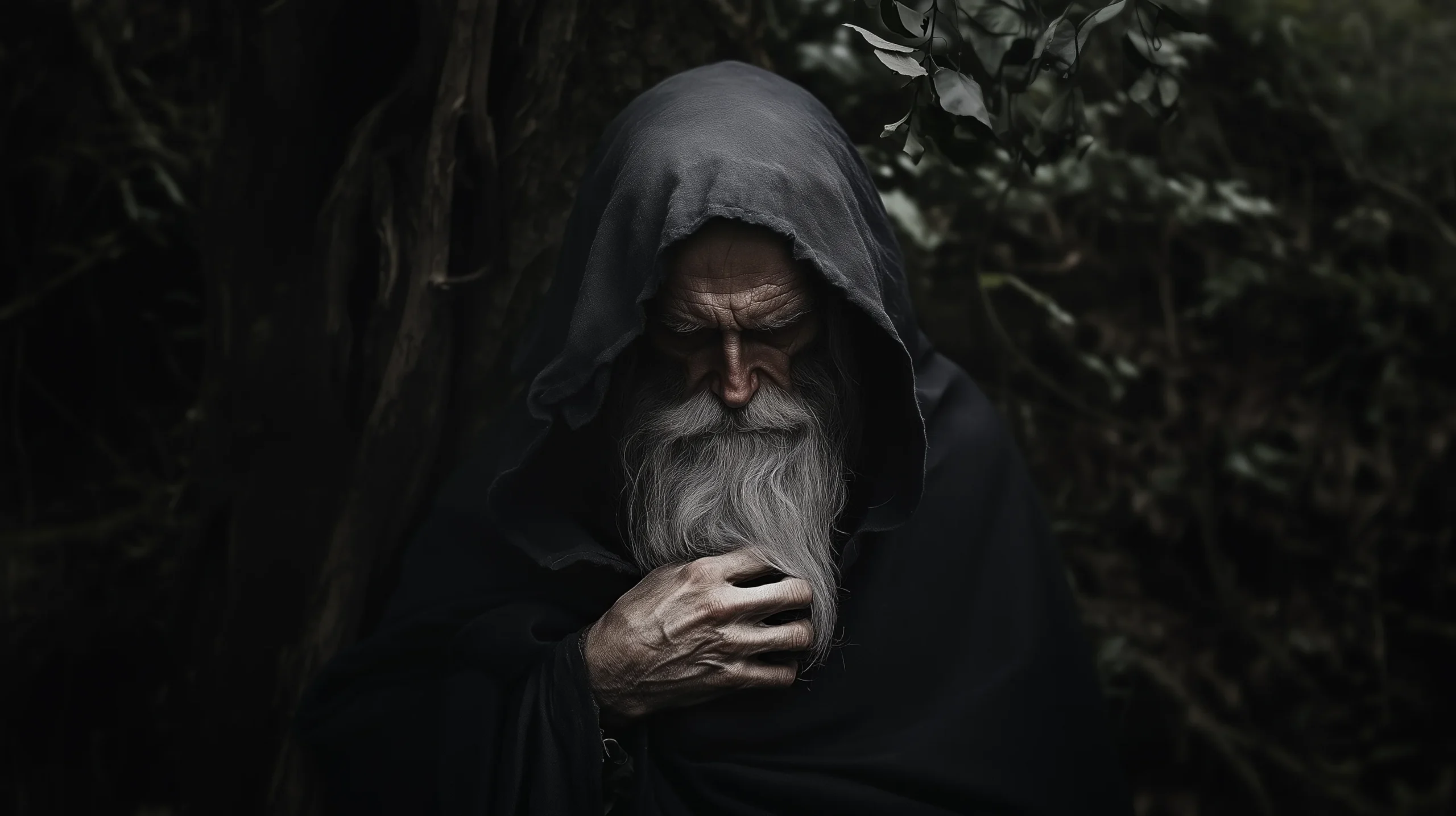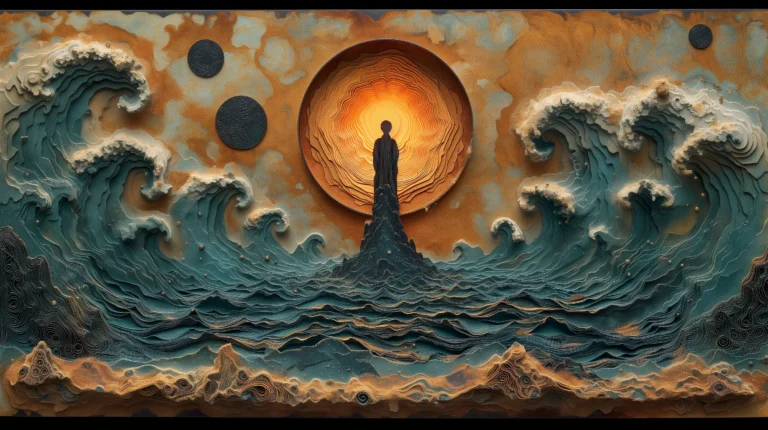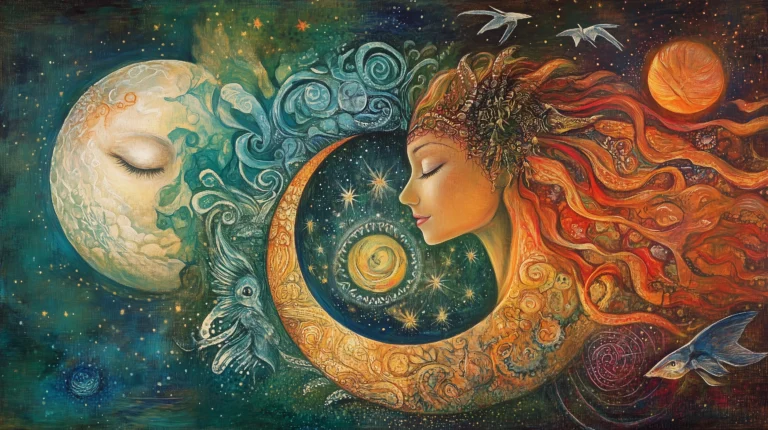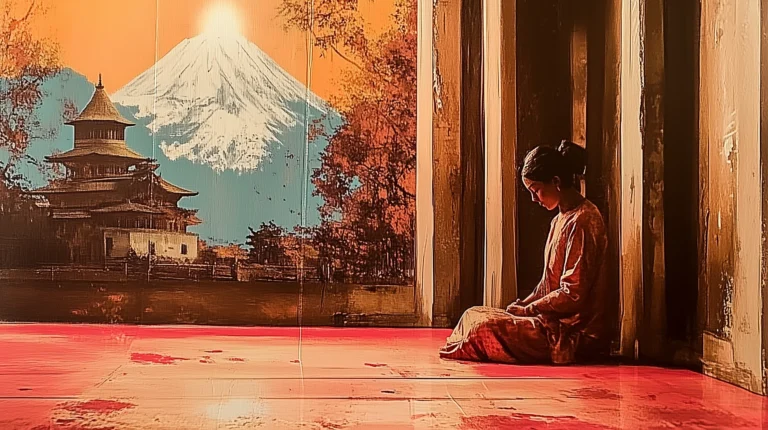Hermes Trismegistus: A Beginner’s Guide to Hermeticism and the Upanishads
Hermes Trismegistus
A Beginner’s Guide to Hermeticism and the Upanishads
“The wise man begins in wonder, and at the end, when doubt is conquered, there is no need for words, for in silence all truth is revealed.”
― Hermes Trismegistus
Across the ages, certain figures transcend time, standing as beacons of ancient wisdom that continue to illuminate the spiritual path for seekers. Hermes Trismegistus, the “Thrice-Great,” is one such figure.
Revered as a bridge between the divine and the earthly realms, he embodies a synthesis of the sacred knowledge of Egypt and Greece, and his teachings resonate through the corridors of history, from the temples of ancient Alexandria to the esoteric schools of the modern era.
This guide invites you to explore the depths of Hermetic wisdom, offering an introduction to the principles and philosophies that have shaped spiritual traditions for centuries.
From the cosmic laws that govern the universe to the inner alchemy that transforms the soul, the teachings of Hermes Trismegistus remain a source of insight for those on the path of self-realization.
As we delve into his teachings, let the words of Hermes open new doors of perception, for those who seek, as the ancient Hermetic maxim reminds us, “shall find.”
Just as Hermeticism offers profound insights into the nature of the universe, so too does the ancient Indian philosophy of the Upanishads.
These sacred texts explore the relationship between the individual soul (Atman) and the ultimate reality (Brahman), providing a parallel to the cosmic principles of Hermeticism.
“In the stillness of the soul, all secrets are revealed, for the true Self is but a reflection of the infinite.”
― Upanishads
In this guide, we will first unravel the core teachings of Hermes Trismegistus, offering a beginner-friendly exploration of Hermetic principles.
Later, we will delve into the wisdom of the Upanishads, drawing comparisons between these two great traditions—one from the West and one from the East—showing how both speak to the same eternal truths about the nature of reality and the divine.
By exploring both traditions, readers will discover how the ancient ideas of immanence, transcendence, and the divine spark within have shaped spiritual understanding across time and culture.
“The lips of wisdom are closed, except to the ears of Understanding”
― Three Initiates, The Kybalion
Who Was Hermes Trismegistus?
“Birth is not the beginning of life – only of an individual awareness. Change into another state is not death – only the ending of this awareness.”
― Hermes Trismegistus
The name Hermes Trismegistus might sound like a character plucked from a fantasy novel, but in reality, he occupies a revered position in the annals of ancient spiritual, philosophical, and esoteric traditions.
His name has graced many texts and teachings, but to understand who he was, it’s essential to journey back into the annals of ancient history and mythology.
The Name
The title ‘Trismegistus’ translates to “Thrice-Greatest,” combining the Greek god Hermes and the Egyptian god Thoth into a singular figure. Both deities were associated with writing, magic, and wisdom.
Hermes: In Greek mythology, Hermes was the messenger of the gods, a mediator between the mortal world and the divine. He was also recognized as the patron of boundaries, travelers, and a guide to souls to the underworld. Hermes was known for his cunning, wit, and wisdom.
Thoth: In Egyptian myths, Thoth was the god of writing, knowledge, and magic. He was often depicted as an ibis or a baboon and was believed to have gifted humanity with writing and sacred knowledge.
By melding these two figures, Hermes Trismegistus represents a synthesis of Greek and Egyptian wisdom traditions, embodying the essence of both and standing as a symbol of universal wisdom.
Historical Context
The figure of Hermes Trismegistus emerged during the Hellenistic period (around. 323-30 BC), a time when Greek and Egyptian cultures were intermingling due to the conquests of Alexander the Great.
The merging of these two civilizations’ religious and philosophical ideas birthed Hermeticism, with Hermes Trismegistus as its central figure.
The Man or The Myth?
There’s ongoing debate among historians and scholars about whether Hermes Trismegistus was a historical figure or a purely mythical one.
Some believe he might have been a real person (or several people) whose teachings got amalgamated over time.
Others argue that he’s entirely legendary—a symbolic figure representing a fusion of Greek and Egyptian wisdom.
Regardless of his historical authenticity, Hermes Trismegistus’s impact is undeniable. His purported teachings have influenced numerous spiritual traditions, including Gnosticism, the Renaissance Hermetic revival, and even modern New Age movements.
The Hermetic Texts
“Man is the most divine of all the beings, for amongst all living things, Atum associates with him only – speaking to him in dreams at night, foretelling the future for him in the flight of birds, the bowels of beasts, and the whispering oak.”
― Hermes Trismegistus, Corpus Hermeticum
Hermes Trismegistus, a fusion of the Greek god Hermes and the Egyptian god Thoth, is most renowned for the collection of writings ascribed to him known as the “Hermetica.”
These texts span a wide array of subjects, including astrology, alchemy, divine knowledge, theology, and philosophy.
Corpus Hermeticum (2nd and 3rd centuries AD): This collection, written primarily in Greek, consists of 17 treatises that delve deeply into subjects like the nature of God, cosmic order, and the journey of the soul.
Many are presented as dialogues between Hermes Trismegistus and his disciples.
The creation of the Corpus Hermeticum occurred during an era of convergence between Greco-Roman and Egyptian religious and philosophical traditions, especially in the intellectual epicenter of Alexandria.
Emerald Tablet (roughly 6th to 8th centuries AD): While not a formal part of the Corpus Hermeticum, the Emerald Tablet is paramount in alchemical traditions.
Its famous proclamation, “As above, so below; as below, so above,” embodies the Hermetic view of the intricate interconnection between the vast universe (macrocosm) and individual entities (microcosm).
Its precise origins and dating remain topics of scholarly debate, but the Emerald Tablet’s significance, especially during the medieval and Renaissance eras, is irrefutable.
It’s worth noting that accurately dating Hermetic texts, especially the likes of the Emerald Tablet, poses challenges due to sparse historical records and the secretive manner in which these teachings were often transmitted.
Yet, their foundational status in diverse esoteric, spiritual, and philosophical traditions over the millennia remains uncontested.
Central to these texts are themes of Cosmology, Theurgy, and Philosophy, which provide profound insights into the worldview of Hermeticism.
“The purpose of our life is twofold: to abide by the laws of the Universe, and to awaken spiritually.”
― Jack Freestone
1. Cosmology:
Cosmology, in a general sense, refers to the study of the universe, its origins, its structure, and its eventual fate. In the context of Hermeticism, however, it involves a specific understanding of the universe and its relationship to the divine.
“Do not make the mistake of supposing that the little world you see around you – the Earth, which is a mere grain of dust in the Universe – is the Universe itself.
There are millions upon millions of such worlds, and greater. And there are millions of millions of such Universes in existence within the Infinite Mind of THE ALL”
― Three Initiates, The Kybalion
Emergence from The One: According to Hermetic cosmology, everything emanates from a single source often termed as “The All” or “The One.” This source is the primal, unknowable essence from which everything – both spiritual and material – is derived.
The Descent and Ascent of the Soul: The soul descends from the spiritual realms, becoming ensnared in the material world. The journey of the soul involves recognizing its divine origins and striving to ascend back to its original state.
The Divine Mind: The first “creation” of The One is the Divine Mind or Nous. It’s the intermediary between the ineffable One and the manifest world, shaping reality through thought.
2. Theurgy:
Theurgy refers to divine or spiritual work, often enacted through rituals and ceremonies. These practices are designed to align the individual with higher spiritual realities and divine forces.
“Theurgy is ritual magic – but magic that enacts the will of God, not of the magician. It brings divine energies down to earth, elevating and spiritualizing the world of matter, including the very being and substance of the participants.
Each time the believer takes part with attention and devotion, he or she becomes more attuned to God.”
― Richard Smoley
Purpose: Unlike mere “magic,” which often seeks to bring about specific worldly effects, theurgy is aimed at the transformation of the practitioner. It’s a means of ascending from the material to the divine.
Rituals and Symbols: Theurgic practices utilize a variety of symbols, words of power, and rituals that correspond to higher realities. The belief is that these practices can draw down divine influences, benefiting the soul.
Divine Communion: At its highest levels, theurgy seeks communion with divine entities, be they gods, angels, or other spiritual beings. This communion can provide insights, purification, and aid in the soul’s ascent.
3. Philosophy:
While philosophy broadly is the study of general and fundamental questions about existence, knowledge, values, and more, within the Hermetic context, it refers to a specific approach to understanding the nature of existence, the soul, and the divine.
Mentalism: A foundational Hermetic principle is “The All is Mind.” Reality, in its essence, is a construct of the Divine Mind. Our own thoughts, being derivative of this Divine Mind, have the power to shape our realities.
Nature of the Soul: The soul, in Hermetic belief, is divine in origin but has become entangled in the material realm. Philosophical reflection and understanding help in recognizing the soul’s true nature and its potential for reintegration with the divine.
“Death is not real, even in the Relative sense — it is but Birth to a new life — and You shall go on, and on, and on, to higher and still higher planes of life, for aeons upon aeons of time. The Universe is your home, and you shall explore its farthest recesses before the end of Time.”
― Three Initiates, The Kybalion
In essence, Hermes Trismegistus stands as an emblem of timeless wisdom, bridging cultures and ages.
For beginners delving into ancient wisdom traditions, he is a doorway to understanding the universality of knowledge and the interconnectedness of various paths to enlightenment.
The Core Teachings of Hermeticism
The Hermetic tradition, stemming from the teachings attributed to Hermes Trismegistus, is anchored in several foundational beliefs. These beliefs act as guiding principles for Hermetic thought and practice:
1. The All is One
This principle expresses the idea that everything in existence is derived from a singular, unified source, commonly referred to as “The All” or “The One.”
Unity of Existence: Despite the myriad forms, manifestations, and diversities in the universe, at its core, everything is interconnected and unified. This unity transcends apparent boundaries, highlighting the interrelatedness of all things.
Implications: Recognizing this unity allows one to see the interconnectedness of events, people, and actions. It teaches that in understanding one part of the universe, one can gain insights into the whole.
“But in this life we are still too weak to see that sight; we have not strength to open our mental eyes, and to behold the beauty of the Good, that incorruptible beauty which no tongue can tell.
Then only will you see it, when you cannot speak of it; for the knowledge of it is deep silence, and supression of all the senses.
He who has apprehended beauty of the Good can apprehend nothing else; he who has seen it can see nothing else; he cannot hear speech about aught else; he cannot move his body at all; he forgets bodily sensations and all bodily movements, and is still.
But the beauty of the Good bathes his mind in light, and takes all his soul up to itself, and draws it forth from the body, and changes the whole man into eternal substance.
For it cannot be, my son, that a soul should become a god while it abides in a human body; it must be changed, and then behold the beauty of the Good, and therewith become a god.”
― Walter Scott, Hermetica: Volume 1
2. As Above, So Below; As Below, So Above
This axiom posits that there’s a correspondence or reflection between the macrocosm (the larger universe) and the microcosm (individual beings, or smaller systems).
Cosmic Correspondence: This principle suggests that patterns repeated at various scales: what happens on a larger scale (cosmic events) can be reflected on a smaller scale (human experiences), and vice versa.
Practical Application: This teaching is at the heart of astrology, alchemy, and many magical traditions. By understanding and working with the patterns in one realm (like the movements of the planets), one can influence and gain insight into another realm (like human destinies).
“He who grasps the truth of the Mental Nature of the Universe is well advanced on The Path to Mastery.”
― Three Initiates, The Kybalion
3. Transformation and Transmutation
This is the belief in the potential for change, particularly the spiritual and moral transformation of individuals.
Spiritual Alchemy: Just as base metals can be transmuted into gold in alchemical practices, the human soul can be refined and elevated to a divine or golden state.
Path of Ascension: Through various practices, teachings, and experiences, individuals can overcome the limitations of their material existence and realize their higher, divine nature.
“The striving for selfish power on the Spiritual Planes inevitably results in the selfish soul losing its spiritual balance and falling back as far as it had previously risen.
But to even such a soul, the opportunity of a return is given — and such souls make the return journey, paying the terrible penalty according to the invariable Law.”
― Three Initiates, Kybalion
4. The Principle of Vibration
Everything in the universe, at its most fundamental level, is in a state of vibration or movement.
Spectrum of Vibration: Different entities, thoughts, or objects have different vibrational frequencies. This variation accounts for the diverse manifestations of existence.
Influence and Attraction: By altering or tuning one’s own vibrational frequency, through thought, emotion, or spiritual practice, one can align with and attract different realities or outcomes.
“the differences between different manifestations of Matter, Energy, Mind, and even Spirit, result largely from varying rates of Vibrations……the higher the vibration, the higher the position in the scale.”
― Three Initiates, The Kybalion
5. The Principle of Polarity
Everything has its opposite, and opposites are identical in nature but different in degree.
“The man who enjoys keenly, is subject to keen suffering; while he who feels but little pain is capable of feeling but little joy. The pig suffers but little mentally, and enjoys but little — he is compensated.
And on the other hand, there are other animals who enjoy keenly, but whose nervous organism and temperament cause them to suffer exquisite degrees of pain. And so it is with Man.
There are temperaments which permit of but low degrees of enjoyment, and equally low degrees of suffering; while there are others which permit the most intense enjoyment, but also the most intense suffering.
The rule is that the capacity for pain and pleasure, in each individual, are balanced. The Law of Compensation is in full operation here.”
― Three Initiates, Kybalion
Dualities: Light and dark, hot and cold, good and evil – these are examples of polarities. While they seem different, they are simply varying degrees on a spectrum.
Balance and Harmony: Recognizing the relationship between polarities can help one find balance and harmony in their life. It allows for a more nuanced understanding of experiences, moving beyond rigid binaries.
6. The Principle of Cause and Effect
“The masses of people are carried along, obedient to their environment; the wills and desires of others stronger than themselves; the effects of inherited tendencies; the suggestions of those about them; and other outward causes; which tend to move them about on the chess-board of life like mere pawns.
By rising above these influencing causes, the advanced Hermetists seek a higher plane of mental action, and by dominating their moods, emotions, impulses and feelings, they create for themselves new characters, qualities and powers, by which they overcome their ordinary environment, and thus become practically players instead of mere Pawns.
Such people help to play the game of life understandingly, instead of being moved about this way and that way by stronger influences and powers and wills. They use the Principle of Cause and Effect, instead of being used by it.
Of course, even the highest are subject to the Principle as it manifests on the higher planes, but on the lower planes of activity, they are Masters instead of Slaves.”
― Three Initiates, Kybalion
Nothing happens by chance; every event has a cause and subsequently becomes the cause of future events.
Chain of Events: This principle underscores the interconnectedness of events. Every action sets off a chain reaction of causes and effects.
Empowerment: Recognizing this principle encourages responsibility for one’s actions. By understanding the potential repercussions, one can make more informed and conscious decisions.
7. The Principle of Gender
This principle posits that both masculine and feminine qualities are present in all things and are necessary for creation and regeneration.
Not Merely Physical: While this principle may evoke thoughts of biological sex, in Hermetic thought, gender transcends physical attributes. It’s more about the inherent qualities and energies that these terms represent.
Masculine and Feminine Energies: The masculine energy is often associated with assertiveness, logic, and action, whereas the feminine energy often correlates with receptivity, intuition, and nurturing.
Harmony and Creation: These energies work in tandem, and when in harmony, result in creation, be it in the form of new ideas, artistic endeavors, or even personal growth.
“The part of the Masculine principle seems to be that of directing a certain inherent energy toward the Feminine principle, and thus starting into activity the creative processes.
But the Feminine principle is the one always doing the active creative work — and this is so on all planes. And yet, each principle is incapable of operative energy without the assistance of the other.
In some of the forms of life, the two principles are combined in one organism. For that matter, everything in the organic world manifests both genders — there is always the Masculine present in the Feminine form, and the Feminine form.
The Hermetic Teachings include much regarding the operation of the two principles of Gender in the production and manifestation of various forms of energy, etc.”
― Three Initiates, Kybalion
8. Divine Pymander
This is the concept of the divine mind or “Nous,” which is an emanation from the Source (The All or The One) and plays a vital role in the creation and maintenance of the Universe.
First Emanation: After The One, the first differentiation is the Divine Mind or Pymander, which contains the archetypal ideas and principles that shape reality.
Connection to Humanity: It’s believed that by aligning with the Pymander through deep contemplation and spiritual practices, individuals can achieve gnosis or direct knowledge of the divine.
“The Infinite Mind of THE ALL is the womb of Universes.”
― Three Initiates, Kybalion
9. Reincarnation and Karma
Many Hermetic traditions believe in the cyclical nature of existence, emphasizing the soul’s journey through various lifetimes and the law of cause and effect spanning these lives.
Soul’s Journey: The soul, on its path to perfection, may incarnate multiple times, learning and evolving with each life.
Karma: The deeds and intentions from one life can influence circumstances in future lives. It’s a cosmic law of justice and balance, ensuring that the soul reaps the outcomes of its actions.
10. The Importance of Direct Experience (Gnosis)
Gnosis is a Greek word meaning “knowledge,” but in the context of Hermeticism and other mystical traditions, it implies direct, experiential knowledge of the divine.
Beyond Intellectual Knowing: Gnosis is not just about accumulating information but involves deep, transformative experiences that provide a direct understanding of spiritual truths.
Meditation and Mystical Practices: Many Hermetic practices are geared towards achieving gnosis, allowing the practitioner to move beyond mere belief into a realm of direct spiritual perception.
11. The Nature of God and Creation
Hermeticism teaches that God is both immanent (present within everything) and transcendent (existing beyond everything). This aligns with Hermetic texts like the Corpus Hermeticum, which describe God as both the source and the substance of all creation, while also being beyond it.
Panentheism: Unlike pantheism (which equates God with the universe), panentheism asserts that while the divine permeates all of creation, it also exists beyond the confines of the material world.
This concept allows for the belief in a divine presence that is both within and beyond the universe, aligning with Hermetic principles.
Continuous Creation: Creation isn’t seen as a one-time event; instead, the Divine continuously emanates and sustains the universe.
12. The Divine Spark Within
“In all things, there is a spark of the divine, waiting to be realized. For the one who seeks beyond appearances, the veil shall be lifted.”
― Hermes Trismegistus
This teaching emphasizes that within each individual resides a spark of the divine.
Innate Divinity: This divine essence within us serves as a guiding light and a connection to the greater cosmos.
Realization: The journey of life, in many ways, is about realizing this inner divinity, nurturing it, and aligning our lives with it.
13. The Power of Mind Over Matter
Stemming from the principle “The All is Mind,” Hermeticism teaches that our thoughts and beliefs can shape and influence our material realities.
Manifestation: Through focused intention, visualization, and belief, one can bring about desired outcomes in the physical world.
Inner Alchemy: By transforming one’s thoughts and inner state, external circumstances can be influenced and changed.
14. The Mystery of Death and the Afterlife
Hermetic teachings often delve into the mysteries of life, death, and what lies beyond.
Cyclical Journey: Life and death are seen as cycles in the eternal journey of the soul.
Afterlife: While specific beliefs can vary, many Hermetic teachings assert that the soul continues its journey after physical death, undergoing various experiences before potentially reincarnating.
15. The Sacredness of Nature
Nature, in all its forms, is seen as a reflection of divine principles and is thus treated with reverence.
Book of Nature: Nature is often described as a book written in the language of symbols. By understanding these symbols, one can gain insights into divine truths.
Harmony: Living in harmony with nature, respecting its cycles and rhythms, is emphasized as a way of aligning with cosmic order.
16. Divine Archetypes and Symbols
Hermeticism often utilizes symbols, archetypes, and mythic narratives to convey spiritual truths.
Universal Symbols: Icons like the Ouroboros (the serpent eating its tail) signify eternity and cyclicality.
Archetypal Figures: Figures such as the divine androgyne represent the union of opposites and the holistic nature of existence.
17. The Principle of Correspondence in Healing
Building on “As Above, So Below,” this principle underscores the interconnectedness of the human body with the cosmos, often used for healing.
Astrological Medicine: Hermetic traditions might use astrological insights to diagnose and treat ailments.
Holistic Approach: Healing isn’t just about the physical; it’s about bringing harmony to the mind, body, and spirit.
18. Sacred Geometry
The study of shapes and patterns that are believed to be fundamental to the structure of the universe.
Platonic Solids: These are geometric forms that Plato associated with the elements — earth, air, water, fire, and the cosmos.
Flower of Life: A pattern found in many ancient cultures believed to represent the cycle of creation, encompassing life, death, and rebirth.
19. The Three Parts of Wisdom
Alchemy, Astrology, and Theurgy are often considered the threefold path to Hermetic wisdom.
Alchemy: Transmutation of the soul and understanding the essence of things.
Astrology: Deciphering the language of the stars to comprehend the cosmic order.
Theurgy: Ritual practices designed to align oneself with divine energies.
20. The Power of Sound and Vibration
Recognizing the power of sound to influence matter and consciousness.
Sacred Chanting: Employing vocalizations to raise one’s vibrational frequency.
Resonance: Understanding that certain frequencies and sounds can promote healing, clarity, and spiritual alignment.
21. The Path of Initiation
The journey of spiritual advancement in Hermetic traditions often involves stages or grades of initiation.
Esoteric Schools: Many Hermetic groups have a structured path of initiation, guiding aspirants through various stages of understanding and practice.
Rites and Rituals: These are used to symbolize and catalyze spiritual transformations in the initiate.
22. Ethical Living
Hermeticism emphasizes living in harmony with natural and divine laws, promoting an ethical way of life.
Golden Rule: As in many spiritual traditions, Hermeticism often upholds the idea of treating others as one would like to be treated.
Living in Balance: This involves recognizing one’s responsibilities to oneself, others, and the cosmos.
In essence, the core teachings of Hermeticism offer a profound and interconnected understanding of the universe, human nature, and divinity. They provide both a philosophical framework and practical tools for navigating and enriching one’s journey through life.
Influence on Alchemy and the Occult
Hermes Trismegistus, the legendary figure that merges Greek and Egyptian wisdom traditions, played a pivotal role in the development of Western esoteric thought, particularly in alchemy and the broader realm of the occult.
Alchemy: The Magnum Opus
Alchemy, often dubbed the precursor to modern chemistry, is an ancient tradition that sought the transmutation of base metals into gold and, more esoterically, the purification and elevation of the human soul.
Philosopher’s Stone: One of the most famous alchemical symbols, this substance was said to be capable of achieving the grand transmutation. Hermetic texts, especially the Emerald Tablet, contain cryptic references to the process of creating the Philosopher’s Stone.
Spiritual Alchemy: Beyond the material quest, alchemists pursued spiritual enlightenment and transformation, often using Hermetic teachings as foundational guidelines. This inner alchemy aimed to refine one’s soul, making it golden in a metaphorical sense.
Philosopher’s Stone, in the spiritual and personal development sense, represents more than the physical transmutation of metals into gold. Esoterically, it symbolizes the transmutation of the self, the purification and perfection of the soul.
The Philosopher’s Stone is the ultimate key to achieving enlightenment, where the lower aspects of the human psyche—desires, fears, and ego—are refined into a higher state of being.
This process is often referred to as inner alchemy, where the “base metals” of our consciousness (our ego, limitations, and attachments) are transformed into the “gold” of spiritual awareness and divine unity.
In the realm of personal development, the Philosopher’s Stone signifies the ascension beyond the local mind, the mind dominated by ego and its incessant demands.
The ego seeks control, desires validation, and thrives on separation, but the true Philosopher’s Stone dissolves this illusion, aligning one with the flow of the universe.
Riding the horse of this higher awareness means living in a state of harmony and alignment, moving with the currents of life without resistance or unnecessary conflict.
This path mirrors Zen philosophy, which teaches the practice of being fully present and flowing with life without clinging or creating new karma.
When one transcends the local mind, they become a clear channel for action, effortlessly responding to life’s challenges without generating conflict or attachment. As the Zen saying goes,
“The Great Way is not difficult for those who have no preferences.”
By embodying this mindset, the individual moves through life without creating ripples of karma, simply flowing, being in tune with the Tao, the natural order of the universe.
Thus, the Philosopher’s Stone is not just a legendary substance; it is the awakening of the inner self to a higher state of consciousness, free from the ego’s illusions, walking in balance with the universe, creating no disharmony, only peace and wisdom.
The Occult Tradition: Hidden Knowledge
The word ‘occult’ comes from the Latin ‘occultus’, meaning hidden or secret. Occult traditions are concerned with esoteric knowledge — insights not readily accessible to everyone but only to those who seek and prepare themselves.
Hermetic Qabalah: Derived in part from the Jewish mystical system of Kabbalah, the Hermetic Qabalah emerged as a distinct esoteric tradition. It incorporated Hermetic principles and became foundational to many Western occult schools, notably the Hermetic Order of the Golden Dawn.
Tarot: While Tarot’s origins remain murky, by the 19th and 20th centuries, it had become intertwined with Hermetic thought. The imagery and symbolism of the Tarot cards, especially in decks like the Rider-Waite, are deeply imbued with Hermetic and alchemical meanings.
Renaissance Revival
The Renaissance period witnessed a renewed interest in Hermetic and alchemical teachings. This revival can be attributed to the rediscovery of classical texts and an enthusiastic drive to reconcile ancient wisdom with Christian theology.
Hermetic Academies: These were established in various parts of Europe, where scholars and mystics studied Hermetic texts, engaged in alchemical experiments, and explored the mysteries of the cosmos.
Famous Figures: Philosophers like Marsilio Ficino and Pico della Mirandola were instrumental in propelling Hermetic thought during the Renaissance. Their works attempted to merge Hermetic wisdom with Christian doctrine, emphasizing the divine nature of humanity and the cosmos.
Modern Occult Movements
The 19th and 20th centuries saw a surge in occult societies and movements, many of which drew heavily on Hermetic teachings.
Hermetic Order of the Golden Dawn: Founded in the late 19th century, this organization was dedicated to the study and practice of the occult, metaphysics, and paranormal activities. It synthesized elements from Hermeticism, Qabalah, astrology, tarot, and other mystical traditions.
Theosophy and Anthroposophy: Movements such as the Theosophical Society, founded by Helena Blavatsky, and Anthroposophy, developed by Rudolf Steiner, were also influenced by Hermetic thought, emphasizing spiritual evolution, reincarnation, and the hidden dimensions of existence.
“Man is a little world–a microcosm inside the great universe. Like a fetus, he is suspended, by all his three spirits, in the matrix of the macrocosmos; and while his terrestrial body is in constant sympathy with its parent earth, his astral soul lives in unison with the sidereal anima mundi.
He is in it, as it is in him, for the world-pervading element fills all space, and is space itself, only shoreless and infinite.
As to his third spirit, the divine, what is it but an infinitesimal ray, one of the countless radiations proceeding directly from the Highest Cause–the Spiritual Light of the World?
This is the trinity of organic and inorganic nature–the spiritual and the physical, which are three in one, and of which Proclus says that ‘The first monad is the Eternal God; the second, eternity; the third, the paradigm, or pattern of the universe;’ the three constituting the Intelligible Triad.”
― Helena Petrovna Blavatsky, Isis Unveiled
The legacy of Hermes Trismegistus and the Hermetic tradition is profound. The synthesis of spiritual, philosophical, and practical wisdom contained within Hermeticism has nurtured generations of seekers.
Its themes of transformation, unity, and the quest for hidden knowledge remain as compelling today as they were millennia ago, continuing to inspire and guide those on the esoteric path.
Hermeticism and the Upanishads
In both Hermeticism and the Upanishads, the nature of God or the divine is explained as having two main aspects: one that is present within the universe (called immanence) and one that exists beyond the universe (called transcendence).
Even though these two traditions come from different parts of the world — Hermeticism from ancient Egypt and Greece, and the Upanishads from India — they both express a similar idea about the relationship between God and creation.
In the Upanishads, the ultimate reality, called Brahman, is described in two ways:
Nirguna Brahman:
This is Brahman without any attributes or qualities. It is the pure, formless aspect of Brahman that exists beyond all things. It cannot be seen, touched, or described because it is beyond all human understanding.
This is the transcendent aspect of Brahman, which is similar to the Hermetic idea of God being beyond creation. Just as God in Hermeticism is said to be higher than the material world, Nirguna Brahman is beyond everything we know in the physical universe.
The Mundaka Upanishad describes this transcendental Brahman as:
“The Imperishable (Brahman) is beyond name and form, beyond the senses, inexhaustible, without beginning and end”
―(Mundaka Upanishad 1.1.6).
This reflects the idea that Brahman in its Nirguna form is infinite and beyond anything that we can experience in the material world.
Saguna Brahman:
This is Brahman with attributes. In this form, Brahman takes on qualities and manifests in the universe as the creative and sustaining force. Saguna Brahman is the immanent aspect of Brahman, meaning that it is present within all things, just like Hermeticism teaches that God is in everything.
This form of Brahman is what we see in the world around us — the stars, nature, and even ourselves.The Taittiriya Upanishad explains this creative aspect of Brahman:
“From Brahman arise space, air, fire, water, earth, and all living beings”
―(Taittiriya Upanishad 2.1.1).
This shows that Saguna Brahman is the source of all creation, bringing everything into existence and sustaining the universe. It is similar to how Hermeticism sees God as present in all parts of the universe, continuously giving life to it.
By combining these two aspects, the Upanishads teach that Brahman is both immanent (present in the world) and transcendent (beyond the world). This is very similar to the Hermetic view of God, which says that God is both within creation and beyond it.
God as Immanent and Transcendent in Hermeticism
In Hermeticism, God is described as both immanent (present in everything) and transcendent (existing beyond everything). This is very similar to how the Upanishads describe Brahman, the ultimate reality.
The Upanishads teach that Brahman is the source of everything in the universe. Brahman is within everything — all people, animals, plants, and even the stars. This is the immanent side of Brahman, meaning that the divine is always present and close to us.
But the Upanishads also teach that Brahman is transcendent, existing beyond the universe and beyond anything we can understand. In other words, Brahman is both within the world and greater than the world.
One of the most famous sayings from the Upanishads, found in the Chandogya Upanishad, is:
“Tat Tvam Asi” — “Thou art That”
―(Chandogya Upanishad 6.8.7).
This means that the true Self (called Atman) — the eternal, unchanging essence within each person — is identical to Brahman, the ultimate reality.
The Atman is not the ego, or the individual personality, but the deepest part of who we truly are beyond thoughts and emotions.
This reflects the idea that the divine resides within each of us, just as Hermeticism teaches that the divine presence exists in all things.
However, just like Hermeticism teaches that God is beyond the material world, the Upanishads explain that Brahman is not limited to the physical universe. The Mundaka Upanishad says:
“Brahman is infinite, and the universe is infinite. The infinite proceeds from the infinite. After taking away the infinite from the infinite, only the infinite remains”
―(Mundaka Upanishad 2.1.2).
This quote shows how Brahman is transcendent and beyond the universe, even though it also fills the universe.
Panentheism: God in All Things, Yet Beyond
The way that both the Upanishads and Hermeticism describe the divine is closest to what is called panentheism.
Panentheism teaches that God is both within the universe and beyond it. This is different from pantheism, which says that God is the same as the universe and nothing more.
In pantheism, the universe and God are the same. But in panentheism, God is in the universe, but also greater than the universe. This is exactly what the Upanishads teach about Brahman, and what Hermeticism says about God.
For example, the Isha Upanishad says:
“The Lord is enshrined in the hearts of all. The Lord is the supreme reality, ever present in creation, yet beyond it”
―(Isha Upanishad 1).
This reflects the idea of panentheism: God is in everything, but God is also more than everything.
Similarly, Hermeticism teaches that God is the source of the universe but also exists beyond the material world.
Just like in the Upanishads, the Hermetic writings speak of the universe as an emanation of God, meaning that the universe comes from God but does not limit God.
Continuous Creation: An Ongoing Process
In both Hermeticism and the Upanishads, creation is not seen as something that happened only once, a long time ago. Instead, creation is a continuous process.
In Hermeticism, God is said to be constantly emanating the universe, meaning that the divine energy or presence is always flowing into the world to sustain it. This idea is also present in the Upanishads.
The Brihadaranyaka Upanishad uses a beautiful metaphor to describe how Brahman creates and sustains the universe. It compares Brahman to a spider that spins a web, then withdraws it:
“As a spider emits and draws in its thread, as herbs grow on the earth, as hair grows on the head and body of a living person, so does everything in the universe arise from Brahman”
―(Brihadaranyaka Upanishad 2.1.20).
This means that creation is not a one-time event but something that is always happening. Brahman is constantly bringing the universe into existence, just like a spider spinning a web, and later withdrawing it.
This mirrors the Hermetic idea that the divine is continuously sustaining the universe.
The Divine Spark: Atman and God Within
Both Hermeticism and the Upanishads teach that there is a divine spark within each person. In Hermeticism, this divine spark is a piece of God’s essence that resides within us, and through spiritual practice, we can become aware of this divine presence.
In the Upanishads, this divine spark is called the Atman, which is the true self. The Upanishads teach that the Atman is not separate from Brahman but is, in fact, the same as Brahman. This reflects the deep connection between each individual and the ultimate reality.
The Katha Upanishad beautifully expresses this idea:
“The Self (Atman) is hidden in all beings and does not shine forth; but it is seen by the wise through a clear and subtle intellect”
―(Katha Upanishad 1.3.12).
This means that Brahman, the divine reality, is present within each of us as the Atman, but it can only be recognized through spiritual wisdom. This is similar to how Hermeticism teaches that the divine is within each person, waiting to be discovered through spiritual awakening.
In both Hermeticism and the Upanishads, the divine is understood to be both within the universe and beyond it.
The Upanishads describe Brahman as the ultimate reality, present in everything but also transcending everything. This matches the Hermetic view of God, which says that God is both within creation and beyond it.
Through continuous creation, the divine sustains the universe, and within each person, a divine spark (the Atman) is present, connecting us to the ultimate reality.
Both traditions invite us to recognize the divine presence not only in the world around us but also within ourselves.
Conclusion
You see, at the end of it all, we’re not just specks of dust spinning on some rock in space. No, we’re much more. We’re the universe itself, tangled up in human skin and bone, trying to make sense of the stars in our veins.
Every last one of us, connected, intertwined, caught in this wild web of existence where every breath you take stirs the air I breathe. We’re interdependent, whether we like it or not.
The Hermetic wisdom tells you it’s all one, just like the Upanishads whisper that you are that. It doesn’t matter if you’re looking east or west, these ancient minds figured it out.
We’re all riding the same train, heading to the same place, whether we’re aware of it or not. It’s not just cosmic poetry; it’s the truth, plain and simple. You hurt someone, you’re hurting yourself. You show compassion, and suddenly the world softens its rough edges.
At the core of all this—Hermeticism, the Upanishads, the universe itself—is a simple law, one that doesn’t need rituals or ceremonies. Do unto others as you’d do unto yourself. That’s it.
Treat the next soul you meet like they’re wearing your skin, walking in your shoes, carrying your burdens. Because in a way, they are. We’re all pieces of the same divine puzzle.
“The wise man begins in wonder,” Hermes said. But the wise man also knows that when the dust settles, and the noise of the world quiets down, what’s left is silence. And in that silence, there’s no need for answers, because there’s nothing left to question.
The truth doesn’t shout, it doesn’t need to. It’s there, waiting, always, to be felt—not in words, but in the space between them. In the silence, all truth is revealed.
Once you see that truth, once you truly feel it, you’ll understand: we are all divine, we are all one.
After silence, after stillness, after the deep revelations of meditation, what comes next is flow—effortless, natural, and alive.
When you release your emotions, let go of fear, and heal your inner wounds, you move into harmony with the universe. This is the essence of Tantra—not just in practice but in every breath, in how you live.
When there is no conflict within, no struggle between the energies of mind and heart, action becomes effortless. Life becomes a dance, a beautiful rhythm, not forced but embraced.
“Flow with whatever may happen, and let your mind be free: Stay centered by accepting whatever you are doing. This is the ultimate,”
―Zhuangzi.
In that release, in surrendering to the current of life, we find bliss. No longer do we struggle; we dance with life itself.
“When you do things from your soul, you feel a river moving in you, a joy,”
―Rumi
Ascend beyond the mind’s limitations, and you discover the pure joy of action without resistance.
This is the flow of being—where silence births movement, stillness gives rise to creation, and the soul dances in tune with the universe.
As Lao Tzu put it,
“To the mind that is still, the whole universe surrenders.”
Harmony of The All
Hermes and Brahman sat for a drink,
Shared a look, didn’t need to think.
“Thrice-Great,” Hermes said with a grin,
“All’s mind, that’s where we begin.”
Brahman laughed, “Sure, kid, that’s cute,
But I’m the everything, there’s no dispute.
Formless and full, I’m the divine spark,
Hidden in shadows, shining in the dark.”
“As above, so below,” Hermes shot back,
“We’re all just atoms in the same cosmic sack.”
“True,” said Brahman, “but here’s the deal:
Your Atman and me? We’re the same for real.”
So they sipped their drinks, as wise men do,
Said, “You know, we’re all just passing through.”
“Treat them like you,” said both with a smile,
“’Cause we’re one, and that’s always in style.”
In the end, they clinked their glass,
And in silence, let the moment pass.
Because truth, it seems, needs no loud shout,
It’s there in the laugh, and the wonder, no doubt.







